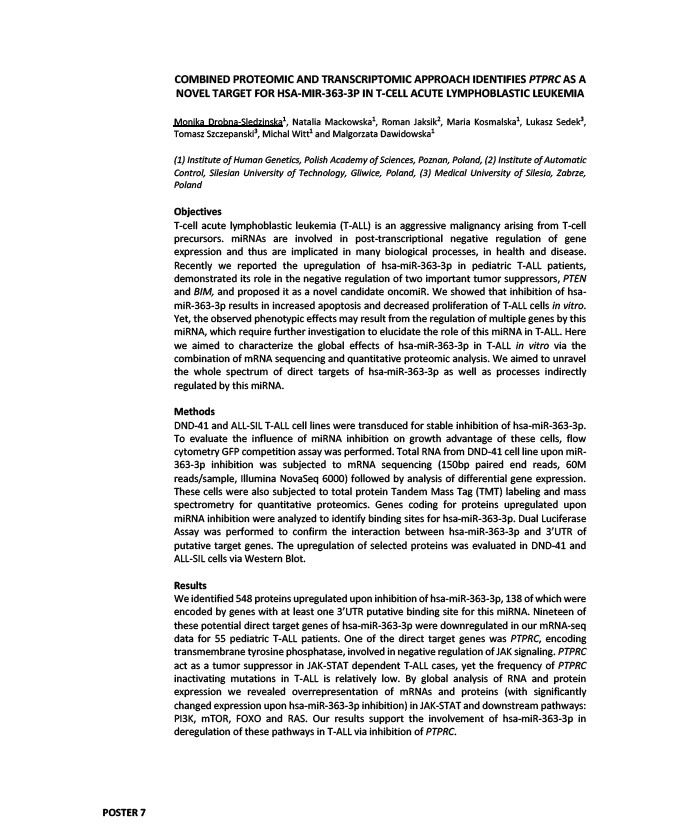
COMBINED PROTEOMIC AND TRANSCRIPTOMIC APPROACH IDENTIFIES PTPRC AS A
NOVEL TARGET FOR HSA-MIR-363-3P IN T-CELL ACUTE LYMPHOBLASTIC LEUKEMIA
Monika Drobna-Sledzinska1, Natalia Mackowska1, Roman Jaksik2, Maria Kosmalska1, Lukasz Sedek3,
Tomasz Szczepanski3, Michal Witt1 and Malgorzata Dawidowska1
(1) Institute of Human Genetics, Polish Academy of Sciences, Poznan, Poland, (2) Institute of Automatic
Control, Silesian University of Technology, Gliwice, Poland, (3) Medical University of Silesia, Zabrze,
Poland
Objectives
T-cell acute lymphoblastic leukemia (T-ALL) is an aggressive malignancy arising from T-cell
precursors. miRNAs are involved in post-transcriptional negative regulation of gene
expression and thus are implicated in many biological processes, in health and disease.
Recently we reported the upregulation of hsa-miR-363-3p in pediatric T-ALL patients,
demonstrated its role in the negative regulation of two important tumor suppressors, PTEN
and BIM, and proposed it as a novel candidate oncomiR. We showed that inhibition of hsa-miR-
363-3p results in increased apoptosis and decreased proliferation of T-ALL cells in vitro.
Yet, the observed phenotypic effects may result from the regulation of multiple genes by this
miRNA, which require further investigation to elucidate the role of this miRNA in T-ALL. Here
we aimed to characterize the global effects of hsa-miR-363-3p in T-ALL in vitro via the
combination of mRNA sequencing and quantitative proteomic analysis. We aimed to unravel
the whole spectrum of direct targets of hsa-miR-363-3p as well as processes indirectly
regulated by this miRNA.
Methods
DND-41 and ALL-SIL T-ALL cell lines were transduced for stable inhibition of hsa-miR-363-3p.
To evaluate the influence of miRNA inhibition on growth advantage of these cells, flow
cytometry GFP competition assay was performed. Total RNA from DND-41 cell line upon miR-
363-3p inhibition was subjected to mRNA sequencing (150bp paired end reads, 60M
reads/sample, Illumina NovaSeq 6000) followed by analysis of differential gene expression.
These cells were also subjected to total protein Tandem Mass Tag (TMT) labeling and mass
spectrometry for quantitative proteomics. Genes coding for proteins upregulated upon
miRNA inhibition were analyzed to identify binding sites for hsa-miR-363-3p. Dual Luciferase
Assay was performed to confirm the interaction between hsa-miR-363-3p and 3’UTR of
putative target genes. The upregulation of selected proteins was evaluated in DND-41 and
ALL-SIL cells via Western Blot.
Results
We identified 548 proteins upregulated upon inhibition of hsa-miR-363-3p, 138 of which were
encoded by genes with at least one 3’UTR putative binding site for this miRNA. Nineteen of
these potential direct target genes of hsa-miR-363-3p were downregulated in our mRNA-seq
data for 55 pediatric T-ALL patients. One of the direct target genes was PTPRC, encoding
transmembrane tyrosine phosphatase, involved in negative regulation of JAK signaling. PTPRC
act as a tumor suppressor in JAK-STAT dependent T-ALL cases, yet the frequency of PTPRC
inactivating mutations in T-ALL is relatively low. By global analysis of RNA and protein
expression we revealed overrepresentation of mRNAs and proteins (with significantly
changed expression upon hsa-miR-363-3p inhibition) in JAK-STAT and downstream pathways:
PI3K, mTOR, FOXO and RAS. Our results support the involvement of hsa-miR-363-3p in
deregulation of these pathways in T-ALL via inhibition of PTPRC.
POSTER 7